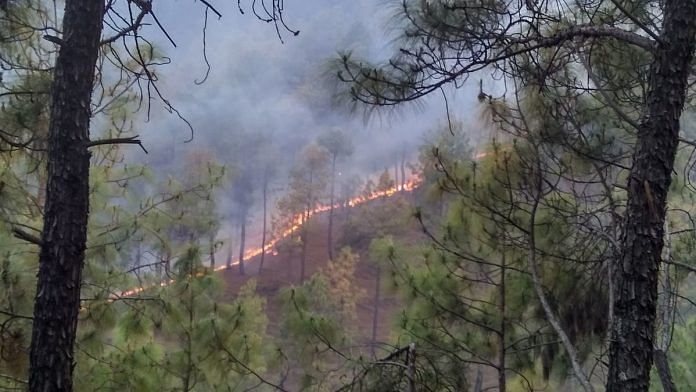New Delhi: In a worrying indication of climate change, the occurrence of intense forest fires has risen ten-fold in India in the past two decades, according to a new study.
India ranked seventh among countries most impacted by climate change in 2019, according to the Global Climate Risk Index, and now a study by the Council on Energy, Environment and Water (CEEW) has found that India’s forests are a major casualty.
Released Thursday, the study found 36 per cent of India’s forest cover falls in zones that are vulnerable to intense forest fires. The frequency and intensity of these forest fires — measured by the number of incidents and total area burned, among other criteria — has steadily increased between 2000 and 2019, according to the study.
The study found that while there were 3,082 forest fires across states in 2000, the number went up to almost 30,947 in 2019. Forest fires also led to a deterioration in air quality.
Districts in Andhra Pradesh, Odisha, Maharashtra, Madhya Pradesh, Chhattisgarh, Uttarakhand, Telangana, and nearly every state in the Northeast (with the exception of Sikkim) are among the worst affected, it found.
“It is evident that climate change is causing fire-favourable weather — hot temperatures, low humidity, and increased dry spells,” said the study, adding, “While forests can mitigate and reverse climate change impacts, there is no denying that climate-proofing forests is the need of the hour.”
A 2021 study by CEEW had found that most districts in India were vulnerable to climate change, marking an increased frequency and intensity of droughts, floods, and cyclones.
“What we have tried to demonstrate with this study is that climate change has made it more conducive for forest fires to spread, whatever be the source,” Abinash Mohanty, lead author of both studies, told ThePrint.
Also read: It is not the heat, but us human beings who are setting South India’s forests on fire
Fires compounded by drought
The study developed a forest fire roster across two decades (2000-2009 and 2010-2019) using several global and national data sets, which were then cross-validated using satellite imagery from the moderate-resolution imaging spectroradiometer (MODIS) sensor.
Since the MODIS sensor is unable to distinguish a forest fire from crop burning, waste burning, and other smaller fires that may occur, the Forest Survey of India’s classification of forest fire-proneness was also used to help identify areas frequently exposed to forest fires. For example, an ‘extremely fire-prone’ forest area is where there have been an average of more than four fires per year, in a measured area.
The researchers further analysed spatio-temporal data across the two decades to identify district level hotspots and rule out small scale or non-forest fires.
Tropical moist deciduous forests, followed by tropical dry deciduous forests, are most vulnerable to forest fires, according to the study.
Rising temperatures “primarily leads to an increased dry season and dry spells, making the land and soil drier and more vulnerable to forest fires,” said the study.
Globally, temperatures have already risen 1.1 degrees above pre-industrial levels. In India, the rise in temperature has been 0.6 degrees since the year 1907.
Of the over 192 districts in India that are vulnerable to extreme forest fires, 89 per cent are in areas that are drought-prone, or display what is termed a “swapping trend” — when traditional flood prone areas become increasingly drought prone.
“This confirms that drought or drought-like conditions are marked with increased dry spells, which in turn ignite the flames of forest fires,” the study says.
Some of the districts that show a “swapping trend” and are vulnerable to intense forest fires are Kandhamal (Odisha), Sheopur (Madhya Pradesh), Udham Singh Nagar (Uttarakhand), and East Godavari (Andhra Pradesh).
India has pledged to create enough forest and tree cover to absorb 2.5 to 3 billion tonnes of carbon dioxide by 2030. It has also pledged to restore 26 million hectares of degraded forests by the same year — promises that are unlikely to be fulfilled unless forest fires are better managed, warned the study.
The study recommended making forest fires a disaster type under the National Disaster Management Act, which it said will “enhance and strengthen the National Plan on Forest Fires by improving its financial allocation and creating a cadre of trained forest firefighters under the National Disaster Response Force (NDRF) and State Disaster Response Force (SDRF).”
The CEEW study added that forest fire alert systems should be developed for forest fires only, as opposed to detecting all kinds of fires, which distorts the data collected. It also recommended improving air quality monitoring in forest fire-prone areas, and increasing the adaptive capacity of forest departments and local communities to deal with an increase in fires.
‘Most forest fires are man-made’
Not all experts, however, agree that classifying forest fires as disasters under the NDMA will be an effective mechanism to address the problem, since most forest fires are man-made — caused by things like stubble burning, jhum cultivation, or fodder management.
“While it’s true that dry spells have increased, it’s important to remember that most fires in India start because of humans, so in that sense, it isn’t a natural disaster. Mitigating forest fires is about awareness and participation, and restoring the sense of ownership local communities have over forests,” Dr Vishal Singh, senior fellow at the Centre for Ecology Development And Research, told ThePrint.
He added that the intensity of forest fires also depends on the maximum temperature reached by the fire, as well as whether it is a surface fire or ground (slow moving) fire, in addition to the extent of area burned and frequency, as identified in the CEEW report.
(Edited by Poulomi Banerjee)
Also read: Lockdown brought cute images of dancing peacocks, not rhino poaching, Uttarakhand forest fires



